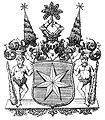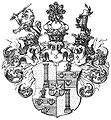
Sten Sture the Younger, was a Swedish nobleman who served as the regent of Sweden, during the era of the Kalmar Union.

Charles VIII, contemporaneously known as Charles II and called Charles I in Norwegian context, was king of Sweden and king of Norway (1449–1450).

Sture was a name borne by three distinct but interrelated noble families in Sweden in the Late Middle Ages and Early Modern Period. It was originally a nickname, meaning 'haughty, proud', but later became a surname. Particularly famous are the three regents from these families who ruled Sweden in succession during the fifty-year period between 1470 and 1520, namely:

The Oxenstierna family is a Swedish noble family, originally from Småland in southern Sweden, and is part of the Swedish uradel, the ancient nobility.
Nils Jönsson Oxenstierna (1390s–1450s) was a Swedish nobleman. During the Kalmar Union, he was co-regent of Sweden, together with his brother Bengt Jönsson Oxenstierna (1390s–1450s) from January to June 1448. He was a member of the Privy Council of Sweden in 1432, Castellan (hövitsman) at Borgholm Castle in 1436, Stäket in 1438, and Nyköping Castle in 1442. Dubbed as knight by King Christopher of Bavaria following his coronation in 1441.

Christina Nilsdotter Gyllenstierna of Fogelvik was a Swedish noblewoman. She was married to the Swedish regent Sten Sture the Younger, and led the Swedish resistance against Christian II of Denmark after the death of her spouse. In her own lifetime she was simply referred to as Fru Kristina, but she has become known in history as Kristina Gyllenstierna because of the house of nobility to which she belonged.
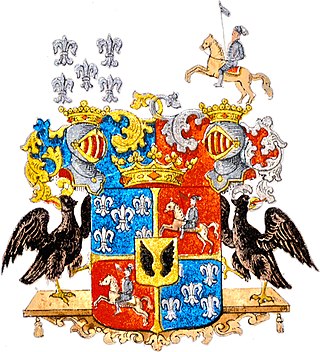
Brahe is the name of two closely related Scanian noble families who were influential in both Danish and Swedish history.

The Engelbrekt rebellion (Engelbrektsupproret) was an uprising during 1434–1436 led by Swedish miner and nobleman Engelbrekt Engelbrektsson and directed against Eric of Pomerania, the king of the Kalmar Union. The uprising, with its center in Dalarna and Bergslagen, spread throughout Svealand and Götaland. The rebellion caused erosion within the unity of the Kalmar Union, leading to the temporary expulsion of Danish forces from Sweden.

Euphemia of Sweden was a Swedish princess. She was Duchess consort of Mecklenburg, heiress of Sweden and of Norway, and mother of King Albert of Sweden. (c. 1338-1412) .
Eskil Magnusson was a nobleman and lawspeaker (Lagman) of Västergötland. He is the first attested legal official in what is now Sweden about whom we have any extensive information.
Cecilia Månsdotter Eka also called Cecilia of Eka, was a Swedish noblewoman. She was the spouse of Erik Johansson Vasa and mother of King Gustav I of Sweden.
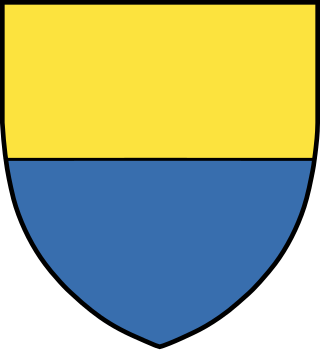
Natt och Dag is a Swedish noble family and the oldest surviving family of pure Swedish extraction, with origins stretching back at least as far as the late thirteenth century. However, the actual name Natt och Dag, alluding to the contrasting colours of its coat of arms, was not coined until the sixteenth century, and was not used as a surname by the family itself until the eighteenth century It is therefore customary to write the name in parentheses when applying it to individuals prior to 1700.
Anna Eriksdotter Bielke was a Swedish noble, commander of the city and castle of Kalmar during the Swedish rebellion against Denmark.

Görvel Fadersdotter (Sparre) was a Swedish noblewoman and county administrator. She was a major landowner in Denmark, Norway, and Sweden.

Roos af Hjelmsäter is a Swedish noble family of Norwegian noble and royal origin. It is among the few of Norway's medieval noble families still living.
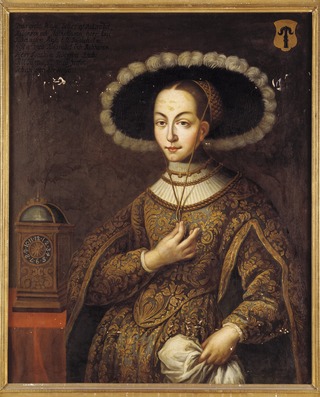
The Westrogothian rebellion, also known as Västgötabullret or Västgötaherrarnas uppror was a Swedish rebellion which took place in the provinces of Småland and Westregothia in Sweden during the spring of 1529. The rebellion was led by members of the nobility, and the purpose was to depose the Swedish monarch King Gustavus Vasa in an attempt to stop the recently initiated Swedish Reformation.
Events from the year 1528 in Sweden
Kristina Nilsdotter Blake, was a Swedish noblewoman. Kristina and her spouse were written of by poet Snorri Sturlasson, who visited them in 1219; they reportedly gave him valuable information for his writings. Kristina was the daughter of princess Catherine of Sweden and Norwegian nobleman Nils Blake. She married the Norwegian earl Hakon the Mad in 1205. He was the half-brother of the Norwegian king Inge Bårdsson. She was the mother of Knut Haakonsson who was later a claimant to the throne during the Civil war era in Norway.
The 1576 Plot was a conspiracy in Sweden in 1576. The purpose was to depose John III of Sweden and reinstate the imprisoned Eric XIV of Sweden on the Swedish throne. It was the last of three major plots to free the imprisoned Eric XIV, and was preceded by the 1569 Plot and the 1574 Mornay Plot.



